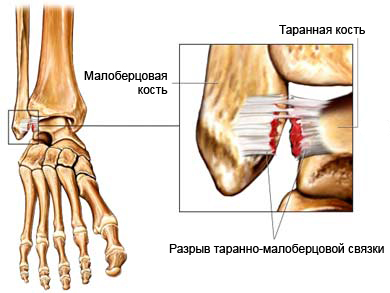Foot sprain – Ankle sprain
Description of ankle sprains
Foot sprain – a partial or complete rupture of ligaments, that support foot. Bundles – fabric bundles, that pass through the joints and connect bone with each other.
A serious injury can lead to fracture of ankle.

Causes of ankle sprains
Ankle sprains may cause:
- Fall;
- Sudden twisting of the foot, such as:
- Hit your feet into the pit, or on uneven surfaces;
- Incorrect setting feet when running, jumping, etc.;
- Fastening the foot inwards when playing sports or workouts (the so-called inversion of the foot).
Risk factors
Factors, that increase the likelihood of ankle sprains:
- Athletics;
- Availability:
- Poor coordination;
- Inability to hold balance;
- Insufficient strength of the muscles and ligaments;
- Weak joints.
The symptoms of ankle sprains
When the dislocation of foot the following symptoms:
- Pain, swelling and bruising around the foot;
- Increased pain when walking, in the standing position, When you click on the injured area or case of foot inside;
- Inability to move the joint golenostopnym without pain;
- Clicking sound at the time of injury ligament rupture (perhaps).
Diagnosis of ankle sprains
Ankle sprain, perhaps, does not require a doctor's visit. But, you need to visit the hospital, If there is a:
- Inability to move the foot without significant pain;
- Inability to move the body weight on the foot;
- Pain in the bony part of the leg or foot;
- Pain, which significantly interferes with walking;
- The pain does not go away after applying ice, taking pain and amplified;
- Numbness in leg, foot or ankle;
- Pain, that does not go away within 5-7 days;
- Uncertainty about the severity of the injury;
- Uncertainty regarding the care of trauma.
Doctor:
- Asked about the symptoms and that, how the accident occurred;
- Examines the foot to assess the severity of injury.
Tests may include:
- Roentgen – To make sure, that the bones not broken;
- MRT – to verify the integrity of ligaments (rarely).
Foot sprain is classified with ligament damage. The more damaged ligaments, the more serious injuries.
1 class
- Some minor tears in the fabric bundles, But foot remained intact.
2-th class
- Partial tear of ligaments;
- Small joint instability;
- Usually includes two ankle ligament damage.
3 class
- Complete break two or three ligaments;
- Significant damage to the joint.
Treatment of ankle sprains
- Recreation – to avoid any pressure on the ankle. To walk it is advisable to use crutches. This method of treatment allowed small sprains;
- Ice – You must apply ice or a cold pack on the ankle during the 15-20 minutes, four times a day for at least 2-3 days. This helps reduce pain and swelling. Need to wrap an ice pack or cold compress towel. You can not apply ice directly to the skin;
- Compression – wrap an elastic bandage the foot from the toes up to the knee. This will limit the swelling of ankle and foot;
- You need to raise the foot above the level of your heart so, as much as possible, during 48 hours. This will help remove the fluid and reduce swelling;
- Receiving oral pain relievers (Ibuprofen, naproxen, paracetamol, aspirin) or in the form of creams, patches, are applied to the skin;
- Rehabilitation exercises help restore flexibility, balance, the volume of movements and the strength of muscles around the foot in line with the recommendations of the physiotherapist;
- Bandage – perhaps, have to wear a brace to immobilize the foot. In many cases, brackets, that stabilize the foot and compress, allow earlier return to activity. When playing sports, You may want to wear some time brackets game;
- Gypsum – very rarely required for sprains foot. Where there are serious sprains, your doctor may recommend a small plaster bandage on 2-3 of the week. In many cases, you can use special braces, that can be used instead of plaster;
- Surgery – the operation is rarely, and necessary for the treatment of ankle sprains, but sometimes it may be needed if injury, in which all three ligaments are torn.
Prevention of ankle sprains
Many sprains foot cannot be prevented. But, You can reduce the risk of dislocation of ankle:
- Stop playing sports or exercise, When you feel tired;
- We need to do the exercises, which strengthens the muscles of the lower leg and foot;
- Need to learn proper technique exercise. This will reduce the load on all muscles, ligaments and tendons, including around the foot;
- When you have foot injuries in the past, There is risk of damaging her again. To reduce the risk of need to use elastic bandage or bandage.
